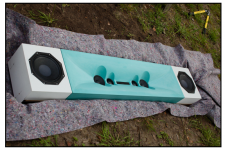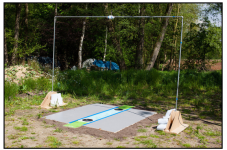With normal box speakers of "normal" baffle width, I usually do far field measurements at a distance of 2.5 x baffle width, or 1 meter, depending on circumstances.
With soffit mount speakers, the baffle is basically the entire wall, floor to ceiling. There is no transition from 2-pi to 4-pi. What are the rules, or best practices, for measuring such systems?
Lets assume that this is a dedicated listening environment, such as a control room or mastering room.
j.
With soffit mount speakers, the baffle is basically the entire wall, floor to ceiling. There is no transition from 2-pi to 4-pi. What are the rules, or best practices, for measuring such systems?
Lets assume that this is a dedicated listening environment, such as a control room or mastering room.
j.
Speaker buried in the ground is one way to do it like Nils Ollerer did here
Aries M Dokumentation - PDF Free Download
Aries M Dokumentation - PDF Free Download
Attachments
In this case, let's assume the speaker system is already installed in a studio, set flush with the walls. It is an active DSP controlled 3 way or 4 way system, and far field measurements of the drivers need to be taken to support the digital crossover development.
Would we do this at 1 meter? or at a distance equivalent to the mixing console (assume 3 meters)? Does it matter?
My thought is that it should not matter much... but I am curious if anyone has experience with setting up this kind of system.
j.
Would we do this at 1 meter? or at a distance equivalent to the mixing console (assume 3 meters)? Does it matter?
My thought is that it should not matter much... but I am curious if anyone has experience with setting up this kind of system.
j.
Hi Jim,
The same principles would apply to measuring individual drivers for crossover development.
I mean your driver is already mounted in cabinets of fixed volume, and very large baffle.
I’d measure at a distance that is far enough so that all the drivers sum- 1 metre should be far enough unless your drivers span more than 1 metre.
How many drivers are there?
If 3 or more you’d want to measure on-axis with each individual driver.
When you develop the crossover you’d want to simulate and optimise for the typical listening position. Eg. 2 or 3m. But if the console and seats (the listening position) are
more of less fixed that’s probably where you want to put your mic as the reference axis, but move it closer, keeping that plane in 3D space, to minimise floor bounce for gated measurements.
Finally for a fixed seating position/listen position with a console it’s probably a good sanity check with an ungated measurement to see what natural in-room base response will be like.
Floor/Ceiling Reflection Calculator
The same principles would apply to measuring individual drivers for crossover development.
I mean your driver is already mounted in cabinets of fixed volume, and very large baffle.
I’d measure at a distance that is far enough so that all the drivers sum- 1 metre should be far enough unless your drivers span more than 1 metre.
How many drivers are there?
If 3 or more you’d want to measure on-axis with each individual driver.
When you develop the crossover you’d want to simulate and optimise for the typical listening position. Eg. 2 or 3m. But if the console and seats (the listening position) are
more of less fixed that’s probably where you want to put your mic as the reference axis, but move it closer, keeping that plane in 3D space, to minimise floor bounce for gated measurements.
Finally for a fixed seating position/listen position with a console it’s probably a good sanity check with an ungated measurement to see what natural in-room base response will be like.
Floor/Ceiling Reflection Calculator
Last edited:
If these are in room then too far back makes it harder to measure lower frequencies.
If they are meant to be a part of the room then measuring in the room makes some sense.. and if you have troubles doing that then you may have to ask whether this is a problem that also affects their function.
If they are meant to be a part of the room then measuring in the room makes some sense.. and if you have troubles doing that then you may have to ask whether this is a problem that also affects their function.
I'd say because some parts of the room are intended to be acting as part of the speaker and some aren't.Why not measure at the intended listening position in that case ?
If I understood correctly the room the system is measured in will also be the same as it will be listened to in the end. Or am I wrong ?
Regards
Charles
Regards
Charles
Unintended reflections such as wall and ceiling (and by unintended I don't mean unexpected), won't necessarily correspond with room power, or frequency response at the listening position, or each other.
Why not measure at the intended listening position in that case ?
Regards
Charles
Soffit mounted monitors are always dialed in at the listening location or plane. Measuring nearfield is pointless, since this isn't where you'd listen. Yes, it can be hard to get repeatable LF measurements far field, but most studio settings employ extensive room treatments to clean up the overall in room response. The most reliable method for dialing in LF is using boundary measurements up to the lower mids, then averaging at various listening locations.
I used to install Westlake monitoring systems. Those are designed to be calibrated at the listening position, far field with the LF averaged at frequencies dictated by room dimensions and proportions as well as factoring in room treatment. Most customers would first have someone come out and consult with them before the room was built and laid out to optimize this. If it was a retrofit install, you would still favor the desk seating location for proper geometry. The console seating distance/location would always be given priority unless the customer preferred otherwise. There usually would be several dsp settings for mid and far field locations (including guest and engineer location, even seating and standing). The LF would be averaged up to 300 Hz in each dsp setting according to listening location, mainly because you would consider the LF output sum of both left and right when adjusting each side at a time. This eliminates HF combing and phase errors influencing the calibration at the centered fair field listening location and allows you to obtain the proper averaged power response.
If I understood correctly the room the system is measured in will also be the same as it will be listened to in the end. Or am I wrong ?
You are correct. The space is a dedicated professional listening environment.
I used to install Westlake monitoring systems. Those are designed to be calibrated at the listening position, far field with the LF averaged at frequencies dictated by room dimensions and proportions as well as factoring in room treatment. Most customers would first have someone come out and consult with them before the room was built and laid out to optimize this. If it was a retrofit install, you would still favor the desk seating location for proper geometry. The console seating distance/location would always be given priority unless the customer preferred otherwise. There usually would be several dsp settings for mid and far field locations (including guest and engineer location, even seating and standing). The LF would be averaged up to 300 Hz in each dsp setting according to listening location, mainly because you would consider the LF output sum of both left and right when adjusting each side at a time. This eliminates HF combing and phase errors influencing the calibration at the centered fair field listening location and allows you to obtain the proper averaged power response.
Thanks profiguy. This is very helpful information.
Thank you to everyone for your thoughts.
j.
- Home
- Loudspeakers
- Multi-Way
- Far Field measurements of soffit-mount (IB) speaker systems

